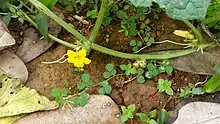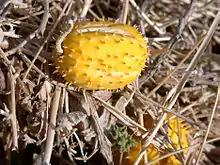Cucumis prophetarum
Cucumis prophetarum is a dioecious and prostrate or climbing perennial vine in the family Cucurbitaceae.[1]
| Cucumis prophetarum | |
|---|---|
 | |
| Leaves of the Cucumis prophetarum plant | |
| Scientific classification | |
| Kingdom: | Plantae |
| Clade: | Tracheophytes |
| Clade: | Angiosperms |
| Clade: | Eudicots |
| Clade: | Rosids |
| Order: | Cucurbitales |
| Family: | Cucurbitaceae |
| Genus: | Cucumis |
| Species: | C. prophetarum |
| Binomial name | |
| Cucumis prophetarum | |
| Synonyms | |
| |


Distribution
Cucumis prophetarum is native to Mauritania east to the Horn of Africa and southwest to Angola, as well as northern South Africa, southern Mozambique, Comoros, and northern Egypt. It is also native to Israel, southern Lebanon, southern Saudi Arabia, Yemen, Oman, United Arab Emirates, and northwestern India. It has been introduced to Qatar, southern Sweden, France, Germany, Spain, Mexico, and California. Cucumis prophetarum subsp. dissectus is native to southern Yemen, southern Oman, and the Horn of Africa southwest to eastern Democratic Republic of the Congo. Cucumis prophetarum subsp. prophetarum is native to southern Saudi Arabia, Yemen, and Oman.[2]
Description
Its stems and leaves are hairy and the leaves are ovate to round in shape and cordate at the bases and measure 2-4 centimeters in length. They have 3-5 blunt-toothed lobes. Male flowers occur in clusters of 2-3 and are rarely solitary; female flowers are always solitary. They have five yellow petals. The fruit is slightly ovoid and is vertically striped and yellow in color when ripe. It measures 3-4 centimeters in length and is covered in spike-like pustules.[3] It grows wild in semi-desert bushland and grassland up to 6594 feet (2010 meters) in elevation, often with acacia trees.[4]
Uses
The fruit is eaten across its native range and occasionally cultivated and sold in local markets.[4] The fruit is also used in folk medicine in Saudi Arabia to treat liver disorders and an extract from it has been proven to contain cytotoxicity against six cancer cell lines.[5] Another extract from the fruit induces an anti-diabetic effect.[6] The fruit has a bitter flavor when raw and is sometimes boiled or pickled and the leaves are cooked and served with a staple.[4]
Taxonomy
It was described by Carl Linnaeus in 1759. It has two subspecies, Cucumis prophetarum subsp. dissectus, which was described in 1962, and Cucumis prophetarum subsp. prophetarum.[7]
Synonyms
This species, Cucumis prophetarum L., has a name that other species may share:
- Cucumis prophetarum Meyer, a synonym for Pseudocucumis naudinianus
- Cucumis prophetarum Wall., a synonym for Cucumis callosus
References
- "cucumis - Encyclopedia of Life". eol.org.
- "Cucumis prophetarum L." www.gbif.org.
- "Cucumis prophetarum - Wild Gourd". www.flowersofindia.net.
- "Cucumis prophetarum - Useful Tropical Plants". tropical.theferns.info.
- Alsayari A, Kopel L, Ahmed MS, Soliman HS, Annadurai S, Halaweish FT (October 2018). "Isolation of anticancer constituents from Cucumis prophetarum var. prophetarum through bioassay-guided fractionation". BMC Complementary and Alternative Medicine. 18 (1): 274. doi:10.1186/s12906-018-2295-5. PMC 6178269. PMID 30301463.
- Kavishankar, G. B.; Lakshmidevi, N. (15 April 2014). "Anti-diabetic effect of a novel N-Trisaccharide isolated from Cucumis prophetarum on streptozotocin-nicotinamide induced type 2 diabetic rats". Phytomedicine: International Journal of Phytotherapy and Phytopharmacology. 21 (5): 624–630. doi:10.1016/j.phymed.2013.12.002. PMID 24462215. Retrieved 20 January 2021.
- "Cucumis prophetarum L." www.gbif.org.